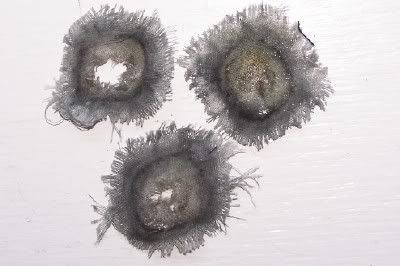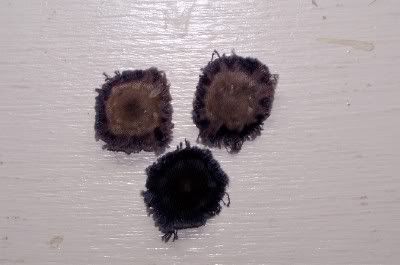We've all heard the warning to never, never use anything but 100% natural fiber of patches. So why is that? I have always just assumed that synthetic would melt in the bore, fail as a patch and perhaps leave a nasty mess in the bore. But on reflection I realize that I have often cut patching form old clothing and some of it surely had some synthetic content.
I decided to put it to the test. In the Walmart fabric section I hunted up the thinnest fabric I could find. It is 65% poly and 35% cotton and measures only .006" thick. This stuff is so thin that when held up close to the eye I could easily identify objects among the clutter of my workbench.
Used this spit lubed and cut at the muzzle to surround a .526" ball over 55 grains of 2f Goex in my .54 smoothrifle, directly atop the powder, no wad.
I fired five shots and got the usual lousy accuracy I have come to expect from this smoothbore. I was able to find only three of the fired patches in the weeds where 3 of 5 is about my normal recovery rate.

I think you can see that 2 of the 3 have a large hole in the center. But looking more closely you'll see that the ragged threads around the hole appear to be torn, not melted. I could find no indication of melting at all. If the tiny threads of such thin fabric won't melt I think melting is just not going to happen with the 65/35 poly/cotton blend.
You would probably not want your girl friend to go out in public in a dress made of this fabric. In private it could be fun but no matter how hot she may be I wouldn't worry about her dress melting. :haha:
I decided to put it to the test. In the Walmart fabric section I hunted up the thinnest fabric I could find. It is 65% poly and 35% cotton and measures only .006" thick. This stuff is so thin that when held up close to the eye I could easily identify objects among the clutter of my workbench.
Used this spit lubed and cut at the muzzle to surround a .526" ball over 55 grains of 2f Goex in my .54 smoothrifle, directly atop the powder, no wad.
I fired five shots and got the usual lousy accuracy I have come to expect from this smoothbore. I was able to find only three of the fired patches in the weeds where 3 of 5 is about my normal recovery rate.

I think you can see that 2 of the 3 have a large hole in the center. But looking more closely you'll see that the ragged threads around the hole appear to be torn, not melted. I could find no indication of melting at all. If the tiny threads of such thin fabric won't melt I think melting is just not going to happen with the 65/35 poly/cotton blend.
You would probably not want your girl friend to go out in public in a dress made of this fabric. In private it could be fun but no matter how hot she may be I wouldn't worry about her dress melting. :haha:






